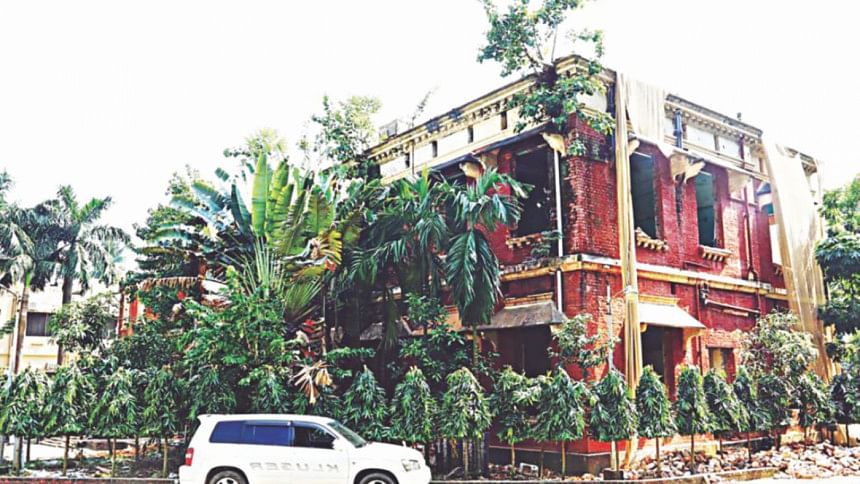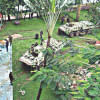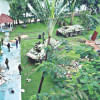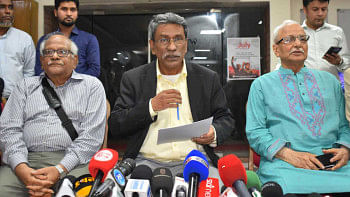Dhaka Attack of another kind

While this year's hit Bangla movie Dhaka Attack was running to packed audiences, there was another kind of attack going on in the heart of Bangladesh's 400-year-old capital city. A demolition team, engaged by the Public Works Department, was razing to the ground a magnificent edifice built in 1909 for agricultural research, known as the Laboratory—the first of its kind in this part of Bengal. A High Court bench had issued an order on October 26, Thursday, to halt demolition until the next Tuesday. Disregarding the order, demolition continued during the weekend at an astonishing speed. On Saturday afternoon, with more than half of the building still intact, a bulldozer was brought in. Within hours, its brutal blades reduced the 108-year-old structure to rubble. To any observer, the whole action would appear as one executed with monstrous rage to inflict maximum possible damage that makes the idea of re-building an utterly nonsensical one.
Rewind ten years to 2007. This time the site was Narinda in Old Dhaka. Binat Bibi Mosque, Dhaka's oldest surviving mosque built during 1454-1457, was being demolished to make space for a larger, multi-storied one. The initiative was taken by none other than the "Mosque Committee." The custodians had earlier been shown at least seven different architectural design proposals—extension schemes that did not require destruction of the historic structure. For reasons unknown, none of these were accepted. The Department of Archaeology, the government agency designated to identify and protect all things relevant to the history and culture of the land, could not stop the merciless tearing down of the 550-year-old mosque. This, as the Department was reported to have said at that time, was "not a protected site." Ironically, neither was the Laboratory.
A little over a month ago, a 200-year-old two-storied house built by Armenian merchant Nicholas Pogose was partly demolished before conservationists obtained a court order to prevent it. Niki Shaheb er Kuthi is of significant archaeological importance, but not listed as such. Last year, the 300-year-old Azimpur Old Graveyard Mosque was all but destroyed to give way to a newer edifice. The mosque was stated to be the last surviving example of an Ottoman-influenced structure with single dome and flanking half-domed vaults. This, again, was not a protected structure. In 2015, a 300-year-old Mughal-era residential building in Shakhari Bazar was almost razed before DoA intervened. Known as Holding No 64, the building was among the 142 buildings listed for protection in the area. During the past seven years, as The Guardian reported in March 2017, more than 500 such historic buildings in Old Dhaka have been demolished. The same report made a chilling prediction about the surviving ones—that Dhaka's "building frenzy would happily claim the rest."
Dhaka appears set to become a city without memories, a city that claims to have 400 years of history but retains little architectural evidence to support it. As our heritage faces a two-pronged attack—from the government and individual owners—there is little doubt that a tragic cultural bankruptcy awaits us.
Unfortunately, the demolitions seldom make headlines in the press, or generate active, sustained protest from the people. It is always a small group of conservationists and conscientious citizens leading the often-futile resistance. Their actions at times trigger hostile reactions, and as seen in the Laboratory case, prompt the bulldozers to work double time. The contemporary society, with its architects and artists, poets and politicians, maintains a blasé indifference to the authenticity of a conservationist's arguments. Judges and journalists are, therefore, his last resort.
But when and how did this corrosive nihilism creep into our collective psyche? Is this phenomenon an inevitable consequence of our destruction of political institutions? Or is it the economy? Whatever the reason, it is a fact that we are comfortable with a depleted state of mind that values money over memories.
Speaking of facts, let us admit that the owners of historic buildings are often in a financial quagmire. With no government initiative to transform a heritage into financially rewarding usage, an inherited property loses its development potential when declared as "protected." The owners feel unjustly deprived and attempt to get the buildings certified as "unsafe" that merit demolition. A sustained campaign over the years to create earthquake impact awareness has not helped the cause of conservation. Often, those leading such campaigns are unacquainted with, or insensitive to, the cultural importance of an area or a building, and hastily prescribe demolition instead of retrofitting.
At the institutional level, there is something terribly amiss with our mindset. Heritage buildings are not held in high esteem. The British can afford to build a new Parliament. Harvard University can take down the 300-year-old Massachusetts Hall to build a high rise. Maharashtra government can opt for a smart communication hub in place of Victoria Terminus. Instead, they have learnt to utilise heritage as a capital. In Dhaka, schools having buildings that date back to early or mid-20th century are attempting to tear them down. The owners of the now-demolished Laboratory building had acres of land at their disposal to develop a master plan with new buildings while proudly highlighting the historic ones. But, evidently, they have no regard for the jewels they possess. The architects working for the government, people who are expected to be sensitive about such issues, did not, or could not, deter the owners either, and instead played the role of a strong supporting cast.
So, is there a win-win solution that can save Dhaka from sinking into heritage bankruptcy? Certainly, there is. Conservation strategists do not need to reinvent the wheel as there are effective tools in use all over the world. One such tool is the concept of Transfer of Development Rights [TDR]. It is a programme that encourages owners of properties marked protected from development to voluntarily sell the development rights to another person or entity, who will then be allowed to utilise the rights to build more than normally permitted at another location. A plot owner in Dhanmondi can buy the development rights of a historic building in Shakhari Bazar and obtain permission from the government to build certain additional floors. The owner of the Shakhari Bazar building retains the ownership of land and can continue using it without further development.
In cities with skyrocketing property prices like New York and Mumbai, TDR is put into use not only to protect heritage sites, but also to protect farmlands and slums. It is unfortunate that many precious years have passed since RAJUK was introduced to the concept of TDR. Dhaka keeps on paying the price in terms of lost heritage as RAJUK delays inserting TDR provisions in the Imarat Nirman Bidhimala.
"National pride is to countries what self-respect is to individuals: a necessary condition for self-improvement," wrote the philosopher Richard Rorty in 1998. As Bangladesh continues to advance on the economic front, a wanton disregard in preserving its heritage only hurts our national pride. The diabolic antihero of the Dhaka Attack movie wanted to blow up Dhaka's landmark buildings, like the National Assembly and High Court, only to be thwarted by the antics of two brave law enforcers. One only hopes that RAJUK and the Department of Archaeology will act heroically to save our historically significant buildings from demolition by the senseless quarters. Buildings are poignant palettes of national identity, history and memories. We should not lose them.
Mamnoon Murshed Chowdhury is an architect based in Dhaka.










Comments